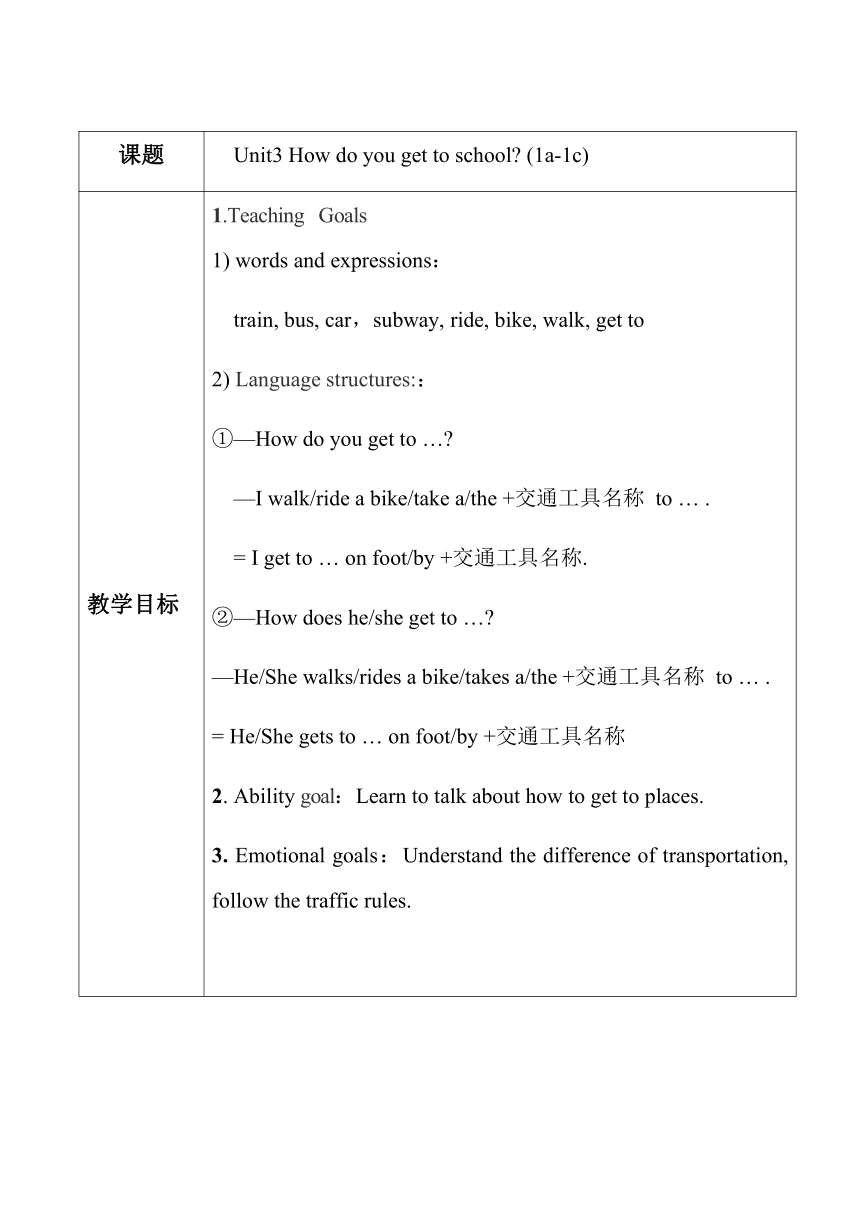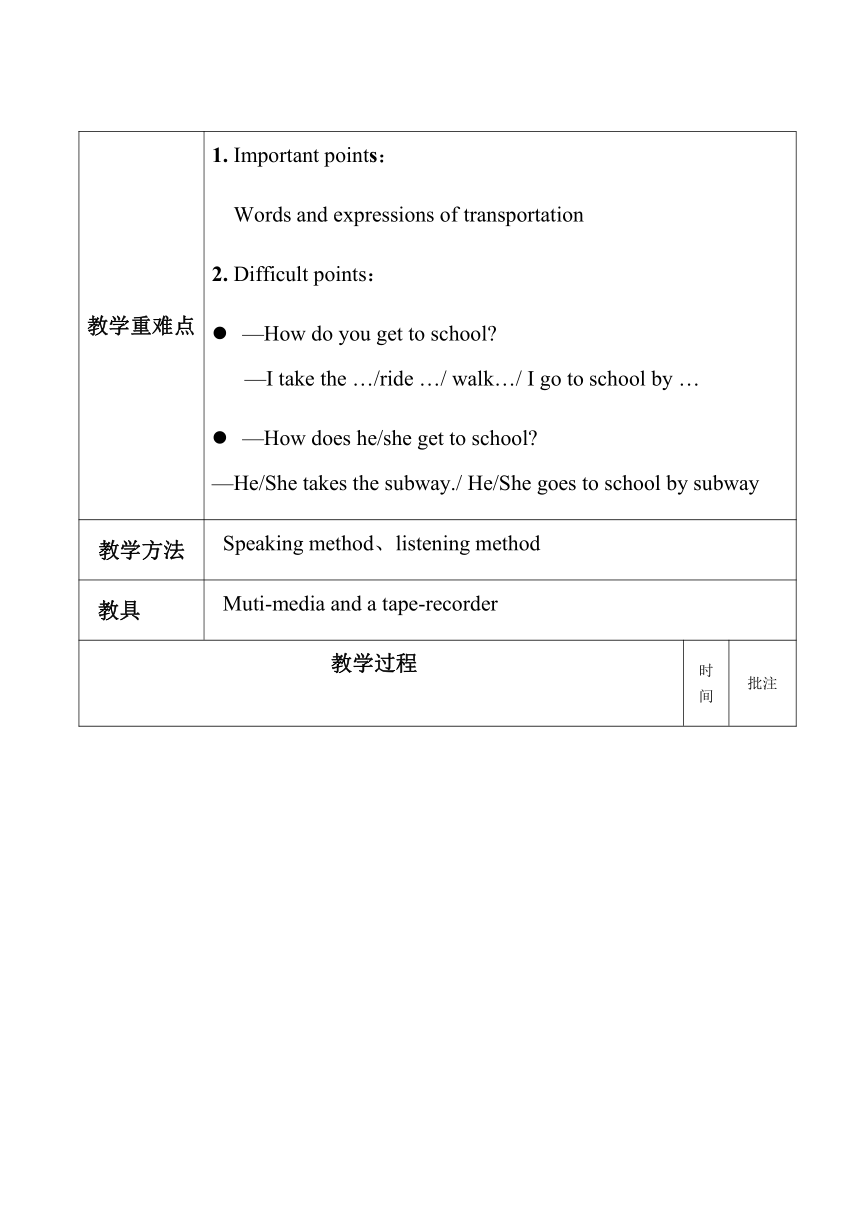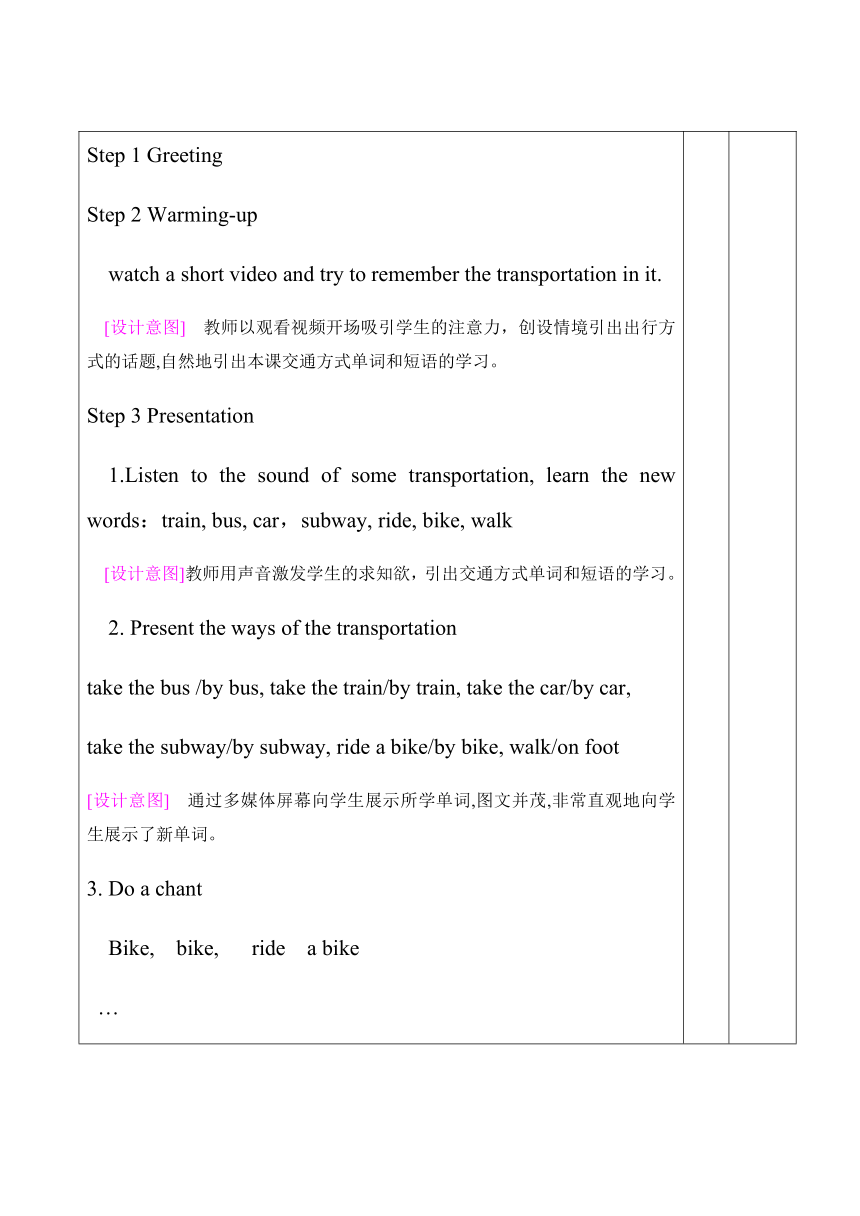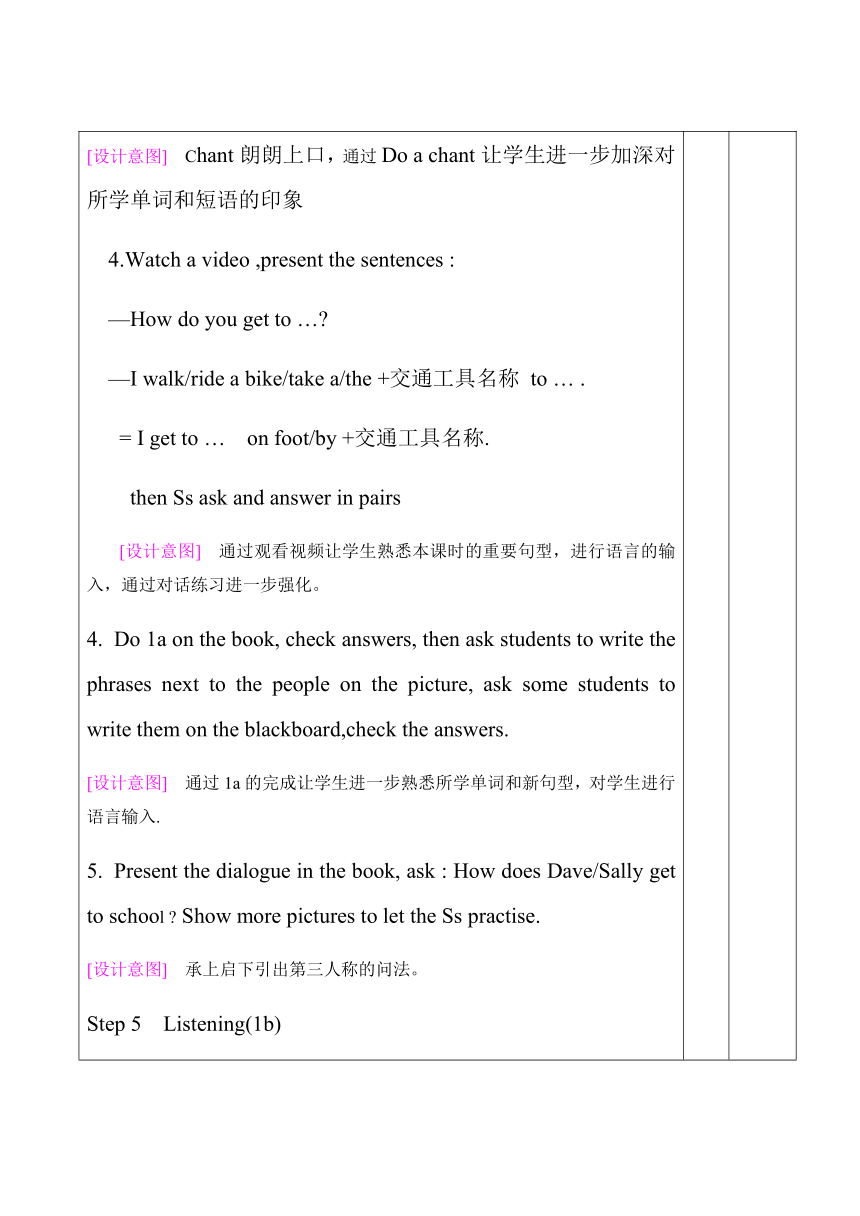人教新目标版英语七年级下Unit 3 How do you get to school?Section A 1a-1c教案(1课时)
文档属性
| 名称 | 人教新目标版英语七年级下Unit 3 How do you get to school?Section A 1a-1c教案(1课时) |  | |
| 格式 | docx | ||
| 文件大小 | 22.5KB | ||
| 资源类型 | 教案 | ||
| 版本资源 | 人教新目标(Go for it)版 | ||
| 科目 | 英语 | ||
| 更新时间 | 2022-03-17 21:43:23 | ||
图片预览




文档简介
课题 Unit3 How do you get to school (1a-1c)
教学目标 1.Teaching Goals 1) words and expressions: train, bus, car,subway, ride, bike, walk, get to 2) Language structures:: ①—How do you get to … —I walk/ride a bike/take a/the +交通工具名称 to … . = I get to … on foot/by +交通工具名称. ②—How does he/she get to … —He/She walks/rides a bike/takes a/the +交通工具名称 to … . = He/She gets to … on foot/by +交通工具名称 2. Ability goal:Learn to talk about how to get to places. 3. Emotional goals:Understand the difference of transportation, follow the traffic rules.
教学重难点 1. Important points: Words and expressions of transportation 2. Difficult points: —How do you get to school —I take the …/ride …/ walk…/ I go to school by … —How does he/she get to school —He/She takes the subway./ He/She goes to school by subway
教学方法 Speaking method、listening method
教具 Muti-media and a tape-recorder
教学过程 时间 批注
Step 1 Greeting Step 2 Warming-up watch a short video and try to remember the transportation in it. [设计意图] 教师以观看视频开场吸引学生的注意力,创设情境引出出行方式的话题,自然地引出本课交通方式单词和短语的学习。 Step 3 Presentation 1.Listen to the sound of some transportation, learn the new words:train, bus, car,subway, ride, bike, walk [设计意图]教师用声音激发学生的求知欲,引出交通方式单词和短语的学习。 2. Present the ways of the transportation take the bus /by bus, take the train/by train, take the car/by car, take the subway/by subway, ride a bike/by bike, walk/on foot [设计意图] 通过多媒体屏幕向学生展示所学单词,图文并茂,非常直观地向学生展示了新单词。 3. Do a chant Bike, bike, ride a bike … [设计意图] Chant朗朗上口,通过Do a chant让学生进一步加深对所学单词和短语的印象 4.Watch a video ,present the sentences : —How do you get to … —I walk/ride a bike/take a/the +交通工具名称 to … . = I get to … on foot/by +交通工具名称. then Ss ask and answer in pairs [设计意图] 通过观看视频让学生熟悉本课时的重要句型,进行语言的输入,通过对话练习进一步强化。 Do 1a on the book, check answers, then ask students to write the phrases next to the people on the picture, ask some students to write them on the blackboard,check the answers. [设计意图] 通过1a的完成让学生进一步熟悉所学单词和新句型,对学生进行语言输入. Present the dialogue in the book, ask : How does Dave/Sally get to school Show more pictures to let the Ss practise. [设计意图] 承上启下引出第三人称的问法。 Step 5 Listening(1b) 1.Listen and do 1b in the book,then check the answers 2. Listen again and read after the tape. 3.Let the Ss try to describe the Ss’ ways of transportation. [设计意图] 通过听力让学生反复学习、训练交通方式的表达,并对于本课的基本句型有了初步印象,并且让他们从听力中感知使用某种交通工具的英语表达,同时通过描述同学们的出行方式而达到语言的输出。 Step 6 Pair work Practice the conversations in 1c [设计意图] 学生在听了细节之后,朗读巩固;再模仿1c的对话,编出自己的对话,培养学生运用目标语言进行交际的能力。 Step 7 Practise and summary Do some choice exercises . 1.— do you get to school —I take the bus. A.Why B.How C.When D.Where 2.How Dave to school every day A.does,get B.did,got C.does,got D.did,get 3.She goes to the library . A.walk B.on foot C.by foot D.in foot 4.How Tom and Mary home A.do,get to B.does,get to C.do,get D.does,get 5.He school every day. A.walks B.walks to C.goes D.on foot 【Keys】 1.B 2.A 3.B 4.C 5.B [设计意图] 以学评教、强化落实。当堂检测主要是由本节内容组成的形成性评价,通过练习巩固所学内容,特别是练习3强调了步行用“on foot”,练习4强调了地点副词“home”前不用介词“to”。 2)Sum up the words、phrases and sentences learned this class. Step 8 Homework 1、Make a survey and then write down the results. Sentence patterns: —How do/does you/he /she get to school —I/He/She …… nameways of getting to school
[设计意图] 学生在学完之后,自己总结本课,再次回顾所学。再通过游戏做采访让学生更好地掌握所学的句型,学以致用。 2、Read some books,search the Internet or ask others.Try to discuss how students around the world get to school. [设计意图] 通过了解别国学生如何上学,为下一节课做好准备,拉近中外之间距离,使同学们放眼全球,扩大视野,况且读书上网查资料,这本身就是一种自我提高,自我超越。
板书 设计 Unit3 How do you get to school Section A(1a-1c) walk= on foot A:How do you get to ...... ride a bike=by bike B:I walk/ride a bike/take a/the +交通工具名称 to … . take the train=by train = I get to … on foot/by +交通工具名称 take the subway=by subway A:How does he/she get to … take the bus=by bus B:He/She walks/rides a bike/takes a/the +交通工具名称 to … . = He/She gets to … on foot/by +交通工具名称
教后反思
教学目标 1.Teaching Goals 1) words and expressions: train, bus, car,subway, ride, bike, walk, get to 2) Language structures:: ①—How do you get to … —I walk/ride a bike/take a/the +交通工具名称 to … . = I get to … on foot/by +交通工具名称. ②—How does he/she get to … —He/She walks/rides a bike/takes a/the +交通工具名称 to … . = He/She gets to … on foot/by +交通工具名称 2. Ability goal:Learn to talk about how to get to places. 3. Emotional goals:Understand the difference of transportation, follow the traffic rules.
教学重难点 1. Important points: Words and expressions of transportation 2. Difficult points: —How do you get to school —I take the …/ride …/ walk…/ I go to school by … —How does he/she get to school —He/She takes the subway./ He/She goes to school by subway
教学方法 Speaking method、listening method
教具 Muti-media and a tape-recorder
教学过程 时间 批注
Step 1 Greeting Step 2 Warming-up watch a short video and try to remember the transportation in it. [设计意图] 教师以观看视频开场吸引学生的注意力,创设情境引出出行方式的话题,自然地引出本课交通方式单词和短语的学习。 Step 3 Presentation 1.Listen to the sound of some transportation, learn the new words:train, bus, car,subway, ride, bike, walk [设计意图]教师用声音激发学生的求知欲,引出交通方式单词和短语的学习。 2. Present the ways of the transportation take the bus /by bus, take the train/by train, take the car/by car, take the subway/by subway, ride a bike/by bike, walk/on foot [设计意图] 通过多媒体屏幕向学生展示所学单词,图文并茂,非常直观地向学生展示了新单词。 3. Do a chant Bike, bike, ride a bike … [设计意图] Chant朗朗上口,通过Do a chant让学生进一步加深对所学单词和短语的印象 4.Watch a video ,present the sentences : —How do you get to … —I walk/ride a bike/take a/the +交通工具名称 to … . = I get to … on foot/by +交通工具名称. then Ss ask and answer in pairs [设计意图] 通过观看视频让学生熟悉本课时的重要句型,进行语言的输入,通过对话练习进一步强化。 Do 1a on the book, check answers, then ask students to write the phrases next to the people on the picture, ask some students to write them on the blackboard,check the answers. [设计意图] 通过1a的完成让学生进一步熟悉所学单词和新句型,对学生进行语言输入. Present the dialogue in the book, ask : How does Dave/Sally get to school Show more pictures to let the Ss practise. [设计意图] 承上启下引出第三人称的问法。 Step 5 Listening(1b) 1.Listen and do 1b in the book,then check the answers 2. Listen again and read after the tape. 3.Let the Ss try to describe the Ss’ ways of transportation. [设计意图] 通过听力让学生反复学习、训练交通方式的表达,并对于本课的基本句型有了初步印象,并且让他们从听力中感知使用某种交通工具的英语表达,同时通过描述同学们的出行方式而达到语言的输出。 Step 6 Pair work Practice the conversations in 1c [设计意图] 学生在听了细节之后,朗读巩固;再模仿1c的对话,编出自己的对话,培养学生运用目标语言进行交际的能力。 Step 7 Practise and summary Do some choice exercises . 1.— do you get to school —I take the bus. A.Why B.How C.When D.Where 2.How Dave to school every day A.does,get B.did,got C.does,got D.did,get 3.She goes to the library . A.walk B.on foot C.by foot D.in foot 4.How Tom and Mary home A.do,get to B.does,get to C.do,get D.does,get 5.He school every day. A.walks B.walks to C.goes D.on foot 【Keys】 1.B 2.A 3.B 4.C 5.B [设计意图] 以学评教、强化落实。当堂检测主要是由本节内容组成的形成性评价,通过练习巩固所学内容,特别是练习3强调了步行用“on foot”,练习4强调了地点副词“home”前不用介词“to”。 2)Sum up the words、phrases and sentences learned this class. Step 8 Homework 1、Make a survey and then write down the results. Sentence patterns: —How do/does you/he /she get to school —I/He/She …… nameways of getting to school
[设计意图] 学生在学完之后,自己总结本课,再次回顾所学。再通过游戏做采访让学生更好地掌握所学的句型,学以致用。 2、Read some books,search the Internet or ask others.Try to discuss how students around the world get to school. [设计意图] 通过了解别国学生如何上学,为下一节课做好准备,拉近中外之间距离,使同学们放眼全球,扩大视野,况且读书上网查资料,这本身就是一种自我提高,自我超越。
板书 设计 Unit3 How do you get to school Section A(1a-1c) walk= on foot A:How do you get to ...... ride a bike=by bike B:I walk/ride a bike/take a/the +交通工具名称 to … . take the train=by train = I get to … on foot/by +交通工具名称 take the subway=by subway A:How does he/she get to … take the bus=by bus B:He/She walks/rides a bike/takes a/the +交通工具名称 to … . = He/She gets to … on foot/by +交通工具名称
教后反思
同课章节目录
- Unit 1 Can you play the guitar?
- Section A
- Section B
- Unit 2 What time do you go to school?
- Section A
- Section B
- Unit 3 How do you get to school?
- Section A
- Section B
- Unit 4 Don't eat in class.
- Section A
- Section B
- Unit 5 Why do you like pandas?
- Section A
- Section B
- Unit 6 I'm watching TV.
- Section A
- Section B
- Review of Units 1-6
- Unit 7 It's raining!
- Section A
- Section B
- Unit 8 Is there a post office near here?
- Section A
- Section B
- Unit 9 What does he look like?
- Section A
- Section B
- Unit 10 I'd like some noodles.
- Section A
- Section B
- Unit 11 How was your school trip?
- Section A
- Section B
- Unit 12 What did you do last weekend?
- Section A
- Section B
